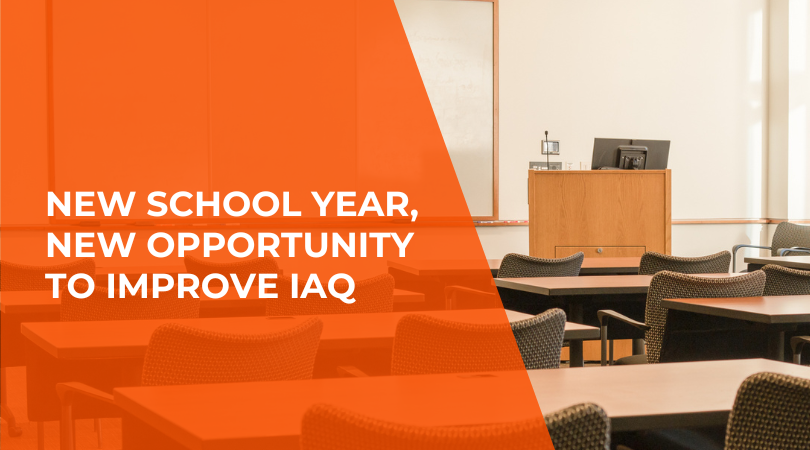The new school year is upon us, and with it comes new opportunities. For students, it’s a chance to start fresh and make new friends. For teachers, it’s an opportunity to create engaging lesson plans and get to know their students. And for facility managers, it’s a perfect opportunity to strategize how you can create a safe, healthy, and productive learning environment.
One thing that should be on top of your priority list is improving your indoor air quality. Here are a few things to keep in mind.
Why is IAQ Important for K-12 Schools?
Indoor air quality is important for any type of building, but it’s especially crucial in schools. Poor IAQ can lead to a number of health problems, including headaches, dizziness, fatigue, and respiratory problems. It can also exacerbate existing conditions like asthma and allergies.
In addition to the physical effects, poor IAQ can also impact cognitive function and learning. Studies have shown that students exposed to high levels of air pollution have lower test scores and are more likely to be absent from school.
The Challenges of Improving Indoor Air Quality in Schools
According to a report released by the U.S. Centers for Disease Control and Prevention (CDC), fewer than 40% of American public schools have replaced or upgraded their HVAC systems since the start of the pandemic and even less (28%) are using high-efficiency particulate air (HEPA) filters.
As concern over the quality of indoor air continues to grow, schools are under increasing pressure to improve the air quality in their facilities. There are many factors that can contribute to poor IAQ. Some are within your control, while others are not.
Indoor Air Pollutants
Pollutants can come from a variety of sources, both inside and outside of your facility. Some common indoor pollutants include:
- Cleaning products
- Paints and varnishes
- Building materials
- Office equipment
- Carpets and upholstery
Outdoor Air Pollutants
Outdoor air pollution is a growing problem in many cities and can seep into your facility through windows, doors, and ventilation systems. Outdoor pollutants can include:
- Traffic fumes
- Dust particles
- Smoke from burning materials
- Pesticides and herbicides
- Poor Ventilation
Is It Time to Invest in a New HVAC System?
Taking a proactive approach to preventing IAQ problems will save your school significant costs in the long run. One of the biggest investments you can make is investing in a modern HVAC System.
There are several signs that your school’s HVAC system is not up to par. If you notice any of the following, consider an upgrade:
- Your school is more than 20 years old.
- The HVAC system doesn’t seem to be working as efficiently as it used to.
- You’re constantly dealing with IAQ problems, despite your best efforts to clean and ventilate the space.
- Staff and students are constantly complaining about the quality of the air in the school.
What to Look for in a New HVAC System
Facility Managers and schools are actively looking for new HVAC systems that will improve IAQ and protect against airborne pathogens like viruses. When evaluating new systems, look for the following features:
Efficiency: Look for an HVAC system that is designed to be energy-efficient. This will help you save money on your energy bills and reduce your school’s carbon footprint.
Indoor Air Quality: Choose an HVAC system that includes features that will improve your school’s IAQ. For example, look for a system with an air filtration system or UV lights to kill mold and bacteria.
Warranties and Service Plans: Make sure the HVAC system you choose comes with a warranty or service plan. This will protect your investment and ensure that you’re getting the best possible value for your money.
Filtration: High-efficiency particulate air (HEPA) filters are designed to capture small particles, like dust and pollen. They are designed to remove 99.97% of particles 0.3 microns or larger from the air.
Consider Investing in a VRF HVAC System
When investing in a new HVAC system, it’s important to look for a system that saves energy, reduces maintenance, and is able to provides a high level of comfort and control.
More schools are investing in VRF systems for their heating and cooling needs. They are excellent for schools and districts looking to reduce their environmental footprint without sacrificing comfort in the process. These systems can deliver both heating and cooling simultaneously, and can easily be retrofitted to existing buildings.
Need Help Selecting the Right HVAC System for Your School?
With the right HVAC system in place, you can improve your school’s IAQ and create a safer, healthier learning environment for your students and staff.
At Downil, we have a wide range of experience in designing and implementing HVAC systems for educational facilities, and we can tailor a solution to meet your specific IAQ needs. Get in touch with us today to explore your options.

